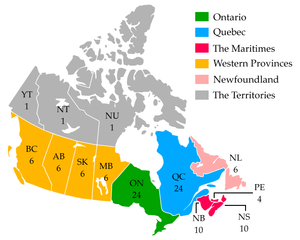The Canadian Senate
Overview
Since the Senate’s creation in 1867 under the Constitution Act, senators have been appointed by the Governor General. [1] The Governor General makes the decisions of appointment based on the recommendations of the Prime Minister. [2]
Dr. Roger Gibbins suggest that these decisions are based on a patronage basis. “The Senate is an unelected body at odds with our most rudimentary understanding of democracy. In a representative democracy, those in control of the legislative process are elected.” [3]

The Senate is comprised of 105 members who must be a minimum of 30 years of age. Senators are allowed to hold their seats until the age of 75.[4] This is problematic as “Senate appointees from past governments confront the elected government of the day.” (Gibbins, 2010). Thus there is much stalemate in the decision-making processes.[5]
Senate Composition Controversies
For years, the Senate’s composition has been the source of debate. Topics often highlighted include the unequal number of Senators from each province and the composition of the Senate being unrepresentative of Canada’s general population.
Provincial Inequality
David E. Smith refers to the distribution of Senate seats as “a maze of compromises, deals and agreements” [6]. The initial aim of the Senate was to create equal representation. Twenty-four Senators represent each of four different parts of Canada: [7]
Senator Divisions:
- Maritimes
- Quebec
- Ontario
- Western
While Senators are distributed across divisions, provinces are given varying amounts of Senate seats. [8]
Senate Seat Distributions By Province:
- Quebec and Ontario - 24 seats each
- New Brunswick and Nova Scotia - 10 seats each
- British Columbia, Alberta, Saskatchewan, and Manitoba - 6 seats each
- Prince Edward Island - 4 seats
The remaining 9 seats represent the regions that were not part of the divisions originally created at Confederation. These include Newfoundland and Labrador, Northwest Territories, Yukon, and Nunavut. [9]

This division of Senate seats has come under scrutiny from many including Aaron Hynes, who argues that this division represents neither representation-by-population nor provincial equality. Hynes also argues that these “are the only two principles that can legitimately bear upon representation in a legislature that is both democratic and federal in nature.” [10]
Unrepresentative of the Population
Research conducted by Kai L. Chan shows that the composition of Senate seats also fails to represent the general population.
Although women make up 50% of the Canadian population, they only account for 27.6% of Senate seats. [11] Similarly, visible minorities comprise 23.3% of Canada’s population, but only represent 12.3% of the Senate [12] Also notable is the median age of Senators, which is not representative of the Canadian population. The median age in Canada is 40.6, while the median age of Senators is 67. [13]
While there has been progress in achieving adequate representation based on population for LGBT and Indigenous communities, there is still much improvement that can be made in regard to gender balance, visible minorities, and age representation.
Efforts to Make the Senate More Democratic
It has been suggested that an elected senate may be both more useful and more democratic. “An elected Senate would act as a much-needed check on the power of the Prime Minister and the central agencies that report to him or her.” [14]
In 2016, an Independent Advisory Board for Senate Appointment was introduced. The Board strives for “Gender, Indigenous and Minority Balance.” [15] In this format, people from the general population are nominated to fill vacant Senate seats. After nomination, a non-partisan five-person board is in charge of deciding the Senate nominees to be recommended to the Prime Minister. [16]
Similarly, scholars such as Aaron Hynes have developed formulas that would ensure that each province is represented in the Senate based on their populations.
Other scholars like Dr. Roger Gibbins point to reform of the design of the Senate. He suggests that reform would have to tackle topics such as the number of Senators from each province and whether it is “constitutional for the Prime Minister to appoint elected Senators”. [17] Dr. Roger Gibbins points out that Senators should “not play this role because they were born into it, because they purchased their way into it, because they took it by force or because an elected official appoints them to the role. They [should be] chosen by the people” [18]
References
- ↑ APPOINTMENTS TO THE SENATE BY PRIME MINISTER http://www.lop.parl.gc.ca/ParlInfo/compilations/senate/Senate_NominationByPM.aspx.
- ↑ Senate http://www.thecanadianencyclopedia.ca/en/article/senate/.
- ↑ Gibbins, Roger; Roach, Robert. A New Senate for a Democratic Canada. Canada West Foundation http://deslibris.ca/ID/222094.
- ↑ Senate http://www.thecanadianencyclopedia.ca/en/article/senate/.
- ↑ Gibbins, Roger; Roach, Robert. A New Senate for a Democratic Canada. Canada West Foundation http://deslibris.ca/ID/222094.
- ↑ Hynes, A. (2010). Toward a rational redistribution of seats in canada's senate. Canadian Parliamentary Review, 33(4), 27-31. http://search.proquest.com/docview/912384326/fulltextPDF/37D58928A7B24ABBPQ/1?accountid=14656.
- ↑ Senate http://www.thecanadianencyclopedia.ca/en/article/senate/.
- ↑ Senate http://www.thecanadianencyclopedia.ca/en/article/senate/.
- ↑ Senate http://www.thecanadianencyclopedia.ca/en/article/senate/.
- ↑ Hynes, A. (2010). Toward a rational redistribution of seats in canada's senate. Canadian Parliamentary Review, 33(4), 27-31. http://search.proquest.com/docview/912384326/fulltextPDF/37D58928A7B24ABBPQ/1?accountid=14656.
- ↑ Keung, Nicholas. (2015). "Parliament’s lack of diversity goes beyond race, gender: study" http://www.thestar.com/news/canada/2015/01/02/parliaments_lack_of_diversity_goes_beyond_race_gender_study.html.
- ↑ Keung, Nicholas. (2015). "Parliament’s lack of diversity goes beyond race, gender: study" http://www.thestar.com/news/canada/2015/01/02/parliaments_lack_of_diversity_goes_beyond_race_gender_study.html.
- ↑ Keung, Nicholas. (2015). "Parliament’s lack of diversity goes beyond race, gender: study" http://www.thestar.com/news/canada/2015/01/02/parliaments_lack_of_diversity_goes_beyond_race_gender_study.html.
- ↑ Gibbins, Roger; Roach, Robert. A New Senate for a Democratic Canada. Canada West Foundation http://deslibris.ca/ID/222094.
- ↑ Independent Advisory Board for Senate Appointments https://www.appointments-nominations.gc.ca/prsnt.asp?page=senat&lang=eng.
- ↑ Hopper, Tristin. (2015)."You too can be a senator: Liberal reforms would let any Canadian apply to Red Chamber." http://news.nationalpost.com/news/canada/canadian-politics/you-too-can-be-a-senator-liberal-reforms-would-let-any-canadian-apply-to-red-chamber.
- ↑ Gibbins, Roger; Roach, Robert. A New Senate for a Democratic Canada. Canada West Foundation http://deslibris.ca/ID/222094.
- ↑ Gibbins, Roger; Roach, Robert. A New Senate for a Democratic Canada. Canada West Foundation http://deslibris.ca/ID/222094.